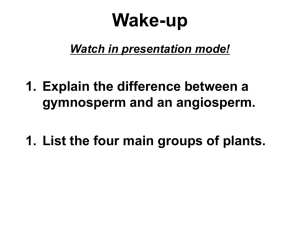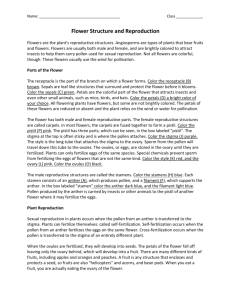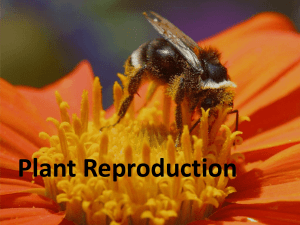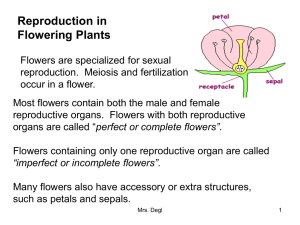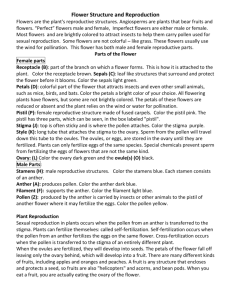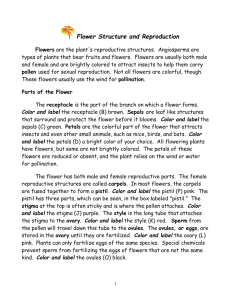Sexual Reproduction in Plants Worksheet for Middle School
advertisement
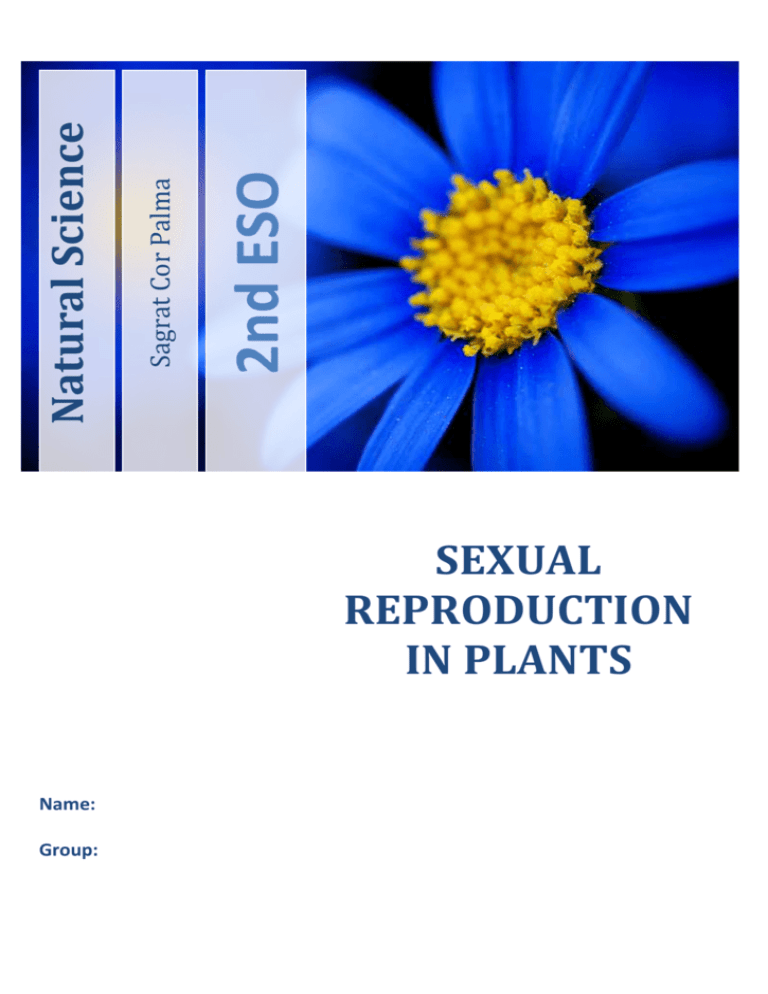
2nd ESO Sagrat Cor Palma Natural Science SEXUAL REPRODUCTION IN PLANTS Name: Group: PARTS OF A FLOWER ACTIVITY 1 In pairs or groups of three, read the definitions and suit them with the names of the parts of a plant. Using the following patterns. I think it is the ………. I think this is the ………… PISTIL CALYX COROLLA FILAMENT ANTHER STIGMA PEDICEL OVARY STAMEN POLLINATION ACTIVITY 2 a) Label each part of the flower with its proper name. b) The flower has male and female parts. Put a letter M besides the Male parts and a letter F besides the Female parts. c) Match the parts of the flower to the function by writing the number in the lines before each sentence. 1. Filament a. b. c. d. 2. Ovary 3. Anther 4. Stigma _______ holds the pollen _______ where the pollen enters the female part of the flower. _______ is the stick that holds the anthers in the air. _______ where the ovules are stored. ACTIVITY 3 Make a set of cards with the name of the plant part on one side and write the definition on the other side. Use them to test yourself and you’ll soon be an expert. ACTIVITY 4 Complete the sentences, by joining a beginning with an ending using the key given and after that, label the parts of the flower. 1 2 3 4 5 6 Beginnings The female sex cell in plants is called The female sex organ in plants is called The female sex organ in plants is made up from The male sex cell in plants is called The male sex organ in plants is called The male sex organ in plants is made up from Endings The filament and the anther. The stigma, style and ovary. The pistil. The stamen. The pollen. The ovule. ACTIVITY 5 Complete this picture with the correct names. ACTIVITY 6 Answer these questions: 1. What is the main difference in appearance between sepals and petals? __________________________________________________________________________ __________________________________________________________________________ __________________________________________________________________________ 2. What is the function of the sepals? __________________________________________________________________________ __________________________________________________________________________ __________________________________________________________________________ 3. What is the function of the petals? __________________________________________________________________________ __________________________________________________________________________ __________________________________________________________________________ ACTIVITY 7 Write in each circle insect pollination (I) or wind pollination (W). The flowers have a strong scent The flowers are not brightly coloured The flowers produce nectar The flowers do not have a scent The flowers have prominent anthes The flowers have sticky pollen The flowers are attractive ACTIVITY 8 (www.mbgnet.net/bioplants/pollination.html) The pollination song: How do plants pollinate? Listen to this song and decide, in groups, the order of the lines in your verse, write numbers from 1 to 7. Then with the whole group find the correct order of each verse. ____ Carry pollen they need. ____ Or the wind that’s blowing. ____ What gets the pollen going ____ Different kinds of birds do, ____ Butterflies and bees, ____ That’s what makes pollination work. ____ To keep new plants growing? ____ Have a sweet perfume ____ That birds and insects active ____ And they’ll spread the pollen as they go. ____ Then chances are good ____ When brightly coloured flowers ____ Find the plants attractive ____ And a sugary nectar ____ And pistils, make the flower whole. ____ The sticky pollen. ____ What does a plant need ____ Reproductive powers, ____ Three things give flowers ____ To make a new seed? ____ The slender stamen, ____ This plant spreads pollen on the wind. ____ Or brightly colored, ____ With stamens longer ____ and the flowers are smaller ____ If a flower’s not scented, ____ The signs are stronger ____ in clusters tighter ACTIVITY REVIEW 9 Complete the following cards and review the new knowledge with your partner. Name the parts of the plant shown here What do plant’s anthers do? Why do flowers have petals? What is the difference between pollination and fertilization?


